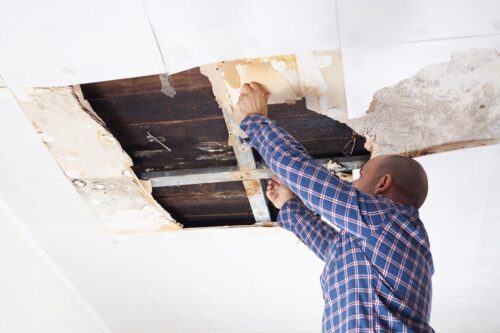
drywall ceiling repair
Drywall Ceiling Repair Explained

drywall ceiling repair
Water damage is a serious concern as it causes huge losses. Typically caused due to extreme weather conditions such as storms and floods, water damage affects more than 14,000 people in the US in a single day. It can even cause damage to the drywall ceiling, causing people to look for a drywall ceiling repair company.
Water damage can be so common that 1 in 60 insured homeowners file a water damage-related claim each year. To put that into perspective, about 1.6 percent of homes in the country experience some kind of water damage in a given year.
We’re talking extensively about water damage as it is one of the main reasons why one may need a drywall ceiling repair. Keep an eye out for anything that could indicate the presence of a leak behind the wall. It’s necessary to locate the source of the leak and take care of it before it can pose any threats to you and your family’s safety or the structure of the house.
Assuming there is a leak and your drywall ceiling has sustained damage, you will have to find a company that offers drywall ceiling repair services. Let’s talk more about it:
What Causes a Leak
There are several reasons behind a leak in drywall ceilings, including:
- Plumbing issues such as broken or rusted pipes are the leading cause of leaks.
- Poor quality pipes that burst due to pressure or other such causes are also a culprit.
- A damaged roof can not only cause leaks but can also result in problems like the growth of mold and higher energy bills.
- Another reason for a leak could be defective home appliances like washing machines and refrigerators.
- AC units cause condensation and this condensation can be a reason for the leak.
- Clogged gutters can also often result in leaks in the ceilings.
How To Identify a Leak
Now that you’re aware of what could cause leaks in your ceiling, let’s move on to how you can identify these leaks. Some clear giveaways are:
- Your ceiling is drooping. Excessive amounts of water absorbed in the drywall can cause the ceiling to visibly bulge and sag. If you see such signs then waste no time and get in touch with a professional ceiling repair company to take care of the damage.
- There are huge stains and discolored patches on the ceiling. Drywalls tend to change color at the slightest contact with water, hence, this is one of the most common signs of leaks.
- You notice mold. This is a major sign because mold is usually only present in damp areas. However, be careful because mold can cause serious health issues. Do not touch it and let a professional remove mold and repair your ceiling.
- Musty stinks around the house also insinuate water damage.
- Cracked or peeling paint is yet another sign of a leak in the ceiling.
It is best that you hire a professional to inspect the ceiling and identify the cause of the leak so that you can correct it.
Should You Repair or Replace The Ceiling?
Now that you are sure of a problem, the question is – shall you repair the ceiling or hire a professional to replace it?
Although many homeowners tend to disregard the obvious signs of a leak, we recommend replacing a drywall ceiling at your earliest convenience. Drywalls can withstand water damage for so long before they lose their resilience.
If drywall is consistently exposed to water, it can get soft and damaged, and could ultimately cause your ceiling and walls to collapse.
With smaller amounts of water damage, however, it could be possible to restore your drywall and not have to replace it completely. It is important to keep in mind that delays can worsen the situation, hence take a step as soon as you identify an issue.
To sum it up, you will need to hire a professional to know if a repair can be enough or if you will have to replace the ceiling.
Side Effects Of Not Repairing or Replacing The Ceiling Drywall
Not choosing to repair or replace the drywall ceiling can come with some side effects. Homeowners who gloss over the problem can expect the drywall to start crumbling and lose its appeal. Moreover, mold may make an appearance resulting in serious health issues.
Mold can be difficult to deal with. Plus, problems with the drywall, even if not serious, can cause your home to suffer and fall in value. Such homes take longer to sell and you may not get a good price if the ceiling is not in good condition.
Repairing definitely costs less but it may not always be the best solution. Replacing, on the other hand, is more expensive but it offers more benefits, including a boost in the value of your property.
Consult with a professional repair company like Get Del Mar to know more about drywall ceiling repair and replacement, including cost. A repair usually costs as low as $300 and as high as $1,500 based on the size of the wall and the nature of the damage. A replacement, however, can cost up to $3 per square foot for installation for a standard wall. It goes up to $175 per square foot for specialized ceilings, such as vaulted or cathedral ceilings.


